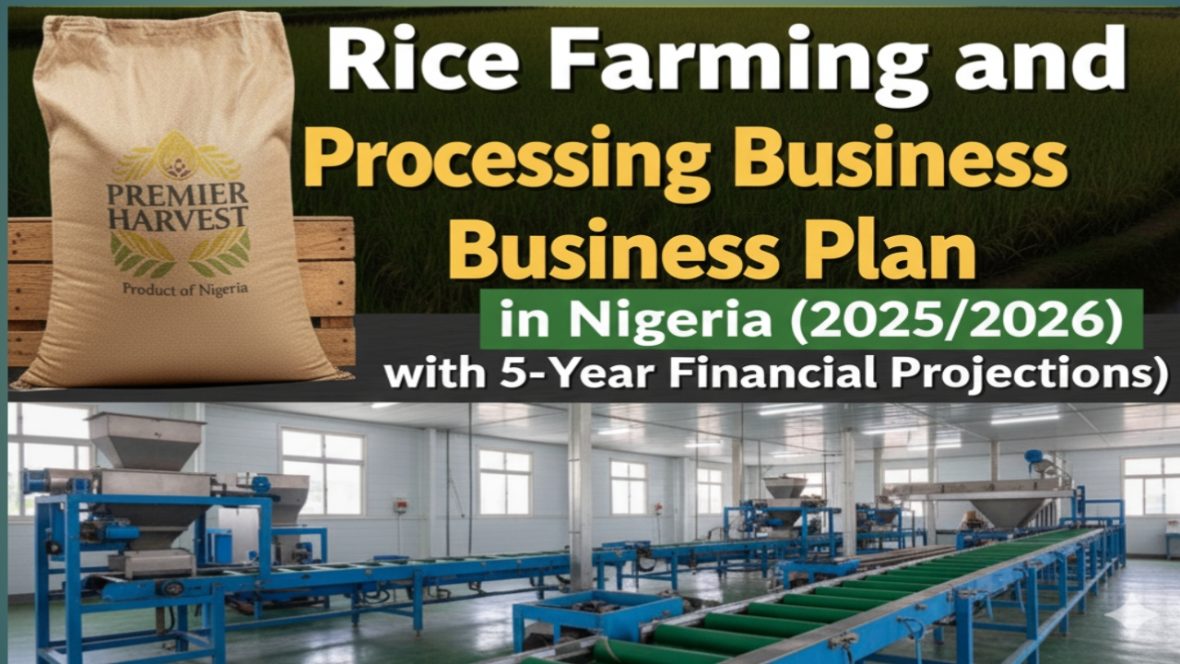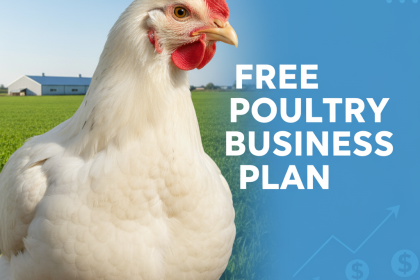📑 Rice Farming & Processing Business Plan in Nigeria (2025/2026 Updated Prices)
1. Title Page
Business Name: Okpara Business Plan Enterprises
Business Address: Number 1 Okpara Street
Prepared by: Okpara Ijezie Kingsley
Contact: 📞 08060777979 | 📧 kingofdata4u@gmail.com
Grant/Loan Amount Sought: ₦5,000,000
Date: October 2025
2. Table of Contents
- Title Page
- Table of Contents
- Executive Summary
- Business Description
- Market Analysis
- Marketing & Sales Strategy
- Operations Plan
- Management & Organization
- Financial Plan (2025 Updated Prices)
- Appendices
3. Executive Summary
Business Overview
Okpara Business Plan Enterprises is a rice farming and processing venture located in Nigeria, seeking to establish a profitable and scalable agribusiness. With the rising demand for locally produced rice due to government import restrictions, our company aims to cultivate rice on a medium-scale farm while processing and packaging it for retail and wholesale distribution.
Mission Statement
To provide affordable, high-quality, and locally processed Nigerian rice while empowering rural communities through job creation and sustainable agriculture.
Vision Statement
To become one of the leading rice farming and processing businesses in Nigeria by 2030, known for quality, affordability, and food security contributions.
Business Objectives
- Secure ₦5,000,000 funding for rice farming and processing operations.
- Cultivate 10 hectares of rice farmland in 2025/2026.
- Process and package at least 50 metric tons of rice yearly.
- Generate annual revenue of ₦20 million by Year 3.
- Create direct and indirect employment for over 20 Nigerians.
4. Business Description
Industry Overview
Rice is one of Nigeria’s staple foods. According to the Nigerian Rice Development Strategy, Nigeria consumes over 7 million metric tons annually but produces only about 5 million tons. This supply gap creates a strong market for local farmers. Government bans on foreign rice importation further boost opportunities for domestic rice processing ventures.
Nature of the Business
The business involves:
- Rice cultivation on owned and leased farmland.
- Milling and processing into polished rice.
- Packaging into 5kg, 10kg, 25kg, and 50kg branded bags.
- Distribution to wholesalers, retailers, and supermarkets.
Value Proposition
- Locally grown, fresh, and healthy rice.
- Affordable pricing compared to imported brands.
- Consistent supply with guaranteed quality.
Products and Services
- Milled rice (white polished rice)
- By-products (rice bran, husk for animal feed and energy use)
- Farm consultancy for small farmers
5. Market Analysis
Current Nigerian Market Trends
- High demand due to population growth (220+ million people).
- Government support through CBN Anchor Borrowers Programme.
- Rising preference for Nigerian-made products.
- Price increases in imported rice create competitive advantage.
Target Market & Customer Segments
- Households (middle- and low-income families).
- Retailers & supermarkets.
- Bulk buyers (restaurants, hotels, caterers).
- Government institutions (schools, military, prisons).
Competitor Analysis
- Major players: Olam Rice, Umza Rice, Ebonyi State Rice, local millers.
- Weakness of competitors: inconsistent quality, poor packaging, high logistics costs.
SWOT Analysis
Strengths:
- Strong demand for rice in Nigeria.
- Availability of fertile land.
- Government support programs.
Weaknesses:
- High initial capital requirement.
- Dependence on seasonal rainfall if irrigation is not provided.
Opportunities:
- Expanding into export markets (ECOWAS).
- Value addition through packaging and branding.
- Agro-allied partnership opportunities.
Threats:
- Pests and diseases.
- Fluctuating government policies.
- Rising cost of inputs (fertilizers, fuel).
6. Marketing & Sales Strategy
Marketing Channels
- Direct farm gate sales.
- Distributors & wholesalers.
- Supermarkets & retail chains.
- Online platforms (Jumia, Konga, social media marketing).
Pricing Strategy
- Competitive pricing slightly lower than imported rice.
- 5kg bag: ₦9,500
- 10kg bag: ₦19,000
- 25kg bag: ₦45,000
- 50kg bag: ₦90,000
Distribution Strategy
- Company-owned vehicles for local distribution.
- Third-party logistics partnerships for nationwide reach.
Promotion Methods
- Social media campaigns.
- Flyers, posters, and banners.
- Community sensitization.
- Participation in food/agricultural trade fairs.
7. Operations Plan
Location & Facilities
- 10 hectares of farmland in a rice-producing area of Nigeria (e.g., Ebonyi, Kebbi, Benue).
- Rice mill facility with de-stoning, polishing, and packaging equipment.
Production Process
- Land preparation → planting → irrigation → harvesting.
- Milling & processing → packaging → distribution.
Technology Requirements
- Small-scale rice mill machine (₦2,500,000).
- Packaging & sealing machines.
- Irrigation pumps and storage silos.
Staffing Needs
- Farm manager (₦100,000/month).
- 5 farm workers (₦60,000/month each).
- Machine operator (₦80,000/month).
- Sales officer (₦70,000/month).
8. Management & Organization
Business Structure
- Sole Proprietorship (with plans to register as a Limited Liability Company).
Roles & Responsibilities
- Owner/CEO: Strategic decisions, funding, partnerships.
- Farm Manager: Oversees farming operations.
- Processing Supervisor: Milling, quality control.
- Sales Officer: Marketing & customer relations.
9. Financial Plan (2025/2026 Updated Prices)
Startup Capital Requirements (₦5,000,000)
| Item | Cost (₦) |
|---|---|
| Land preparation & irrigation | 800,000 |
| Seeds & fertilizer | 600,000 |
| Rice milling machine | 2,500,000 |
| Packaging materials | 400,000 |
| Labour (first 6 months) | 500,000 |
| Logistics & distribution | 200,000 |
| Working capital/reserve | 0,000 |
| Total | ₦5,000,000 |
Operating Expenses (Yearly Estimate)
| Expense | Monthly (₦) | Yearly (₦) |
|---|---|---|
| Staff salaries | 430,000 | 5,160,000 |
| Fertilizer & farm inputs | 100,000 | 1,200,000 |
| Packaging & branding | 120,000 | 1,440,000 |
| Logistics & transport | 150,000 | 1,800,000 |
| Miscellaneous | 50,000 | 600,000 |
| Total | 850,000 | 10,200,000 |
Sales Forecast (₦)
| Year | Quantity (50kg bags) | Sales Revenue |
|---|---|---|
| 2025 | 2,000 | 180,000,000 |
| 2026 | 3,000 | 270,000,000 |
| 2027 | 4,500 | 405,000,000 |
Profit & Loss Projection (₦)
| Year | Revenue | Expenses | Net Profit |
|---|---|---|---|
| 2025 | 180,000,000 | 10,200,000 | 169,800,000 |
| 2026 | 270,000,000 | 12,000,000 | 258,000,000 |
| 2027 | 405,000,000 | 14,000,000 | 391,000,000 |
Five-Year Financial Projections
| Year | Revenue (₦) | Expenses (₦) | Profit (₦) |
|---|---|---|---|
| 2025 | 180,000,000 | 10,200,000 | 169,800,000 |
| 2026 | 270,000,000 | 12,000,000 | 258,000,000 |
| 2027 | 405,000,000 | 14,000,000 | 391,000,000 |
| 2028 | 500,000,000 | 16,500,000 | 483,500,000 |
| 2029 | 650,000,000 | 20,000,000 | 630,000,000 |
Break-even Analysis
- Total fixed costs: ₦10.2 million.
- Average selling price per 50kg bag: ₦90,000.
- Break-even point = ₦10,200,000 ÷ ₦90,000 ≈ 114 bags.
This shows profitability after selling just 114 bags annually, which is far below the target sales.
10. Appendices
- Financial graphs (sales growth & profit margin).
- SWOT chart.
- Sample packaging design.
📌 If you need a complete business plan with a downloadable Excel financial model customized to your specifications, contact:
Okpara Ijezie Kingsley
📞 08060777979
📧 kingofdata4u@gmail.com




